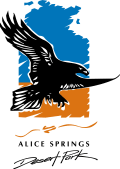| Alice Springs Desert Park | |
|---|---|
 Alice Springs Desert Park logo | |
 | |
| 23°42′23″S133°49′57″E / 23.7065°S 133.8325°E | |
| Date opened | March 1997 |
| Location | Alice Springs, Northern Territory, Australia |
| Land area | 1,300 hectares (3,212 acres) [1] |
| No. of species | 120 [2] |
| Annual visitors | 68,300 (2017) [3] |
| Memberships | Zoo and Aquarium Association, [4] Botanic Gardens Conservation International [5] |
| Major exhibits | Desert Rivers, Sand Country, Nocturnal House, Woodland |
| Owner | Parks and Wildlife Commission of the Northern Territory [6] |
| Website | alicespringsdesertpark |

The Alice Springs Desert Park is an environmental education facility and wildlife park in Alice Springs in the Northern Territory of Australia.
Contents
It is sited on 1,300 hectares (3,212 acres), with a core area of 52 hectares (128 acres). It is an institutional member of the Zoo and Aquarium Association and Botanic Gardens Conservation International.
The park contains native animals and plants representative of Central Australian desert environments, and contributes to their conservation through research programs as well as through public education. It offers people the opportunity to experience the variety of the deserts of central Australia, exploring the relationships between the plants, animals and people.
The area is culturally important to the local Arrernte people. Much of the work of the park is under the auspices of their decision-makers and caretakers – people once known as the park's traditional owners. [7] [8]
